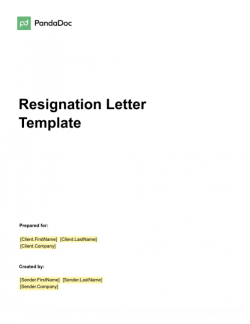Changing jobs is a necessary part of moving up the ladder and contributing to the workforce. In fact, the median number of years professionals stay with their current employer is just 4 years in the United States.
Given that we aren’t bound to lifetime careers, writing a letter of resignation is a necessary formality we all have to face.
What is a letter of resignation?
A letter of resignation (also called a notice of resignation or job resignation letter) is a formal document that informs your current employer about your decision to leave the company. Letters of resignation give you an opportunity to make a good final impression on your current boss and to leave the company in good standing.
You may wonder, is a letter of resignation really mandatory? Yes, yes it is.
While workplace etiquette may vary across industries, submitting a letter of resignation when leaving a job is always an appropriate move. After all, the company took a chance on you when they hired you. Now, it’s time for you to return the favor and professionally provide information about your decision to leave the company.
General resignation letter guidelines
Professional resignation letters observe a format and must include key items. Be sure to open your letter with a formal greeting and list the current date, and then follow a general format which includes:
- Your name
- Job title
- Official resignation
- Date of your last day
- Gratitude statement
- Signature
- Updated contact information.
In addition, always start your resignation letter with pertinent information. State your decision to resign and your last date of work in the first few sentences of your formal letter of resignation.
After you get the necessary details out of the way, you can add a personalized touch to your formal notice letter.
Now that we’ve got the general guidelines out of the way, here are a few ways you can format your very own letter of resignation.
Resignation letter examples
You may be leaving your job for personal reasons. Perhaps your partner landed a new job in your dream city, or maybe it’s time to retire.
No matter what your reason for leaving, here’s a good example of a generic resignation letter template:
Dear Mr./Mrs. [Manager’s Last Name],
Thank you for the opportunity to contribute to [Company Name] during the last three years. This letter is to inform you I am resigning from my position with my last date of employment being [mm/dd/yy].
I have appreciated the skills and experience gained through this position and only hope the best for [Company Name] in the future. I would like to make my last days with [Company Name] productive and meaningful. Please let me know how I can help make the transition as smooth as possible. I have listed my contact information below if you need to reach me after my last day of employment.
Thank you
[Your Signature]
[Print Name] [Your Position] [Today’s Date]
[Phone Number] [Email]
Easy enough, right? This resignation letter sample checks all the necessary boxes.
But resigning from a company isn’t always simple. You may need to leave a company on good terms for more personal reasons. What should you do then?
Resigning for personal reasons
There are many reasons to leave a job. However, the reason and the choice for leaving is completely up to you.
Here are a few examples of appropriate language to use if you decide to communicate your reason for leaving.
I have appreciated the opportunity [Company Name] has given me during my employment. However, I have reached the decision to resign because I will be moving away from [Your Current Industry] to begin a career in [Your New Industry].
Thank you for allowing me to learn and develop new skills at [Company Name]. While I have appreciated this experience greatly, I am looking forward to continuing my personal development through additional education upon my departure from [Company Name].
Generally, it is not advised to tell your employer you’re leaving the company for a higher-paying position elsewhere.
But remember, you are not obligated to list your reason for resigning. Explaining your reasoning is a personal choice.
Last day of work
Before submitting your official letter of resignation, you’ll need to review any employment contracts you are bound to. Some companies require employees to give a specific notice period before their departure.
Check your files or contact your human resources department to review these potential requirements.
Two weeks notice
In most workplaces, it is standard to give your employer two weeks’ notice before your final day on the job. Therefore, the date you list as your last day of employment should be two weeks away from the date of your formal resignation letter.
Even though this is a typical time frame, you may need to give shorter notice depending on your situation.
Say, for instance, an immediate family member has fallen ill. During sensitive times like these, you may only be able to give your employer a week’s notice or less. Be sure to explain this in your resignation letter. For example:
Although I would prefer to give a full two weeks’ notice for my resignation, emergency family circumstances have required me to provide only 7 days’ notice. My last day of work will be [mm/dd/yy]. I understand this short notice is not ideal and apologize for any hardship this may cause [Company Name].
Emergencies happen, and you’ll need to be transparent about your situation in your letter of resignation as to not damage networking opportunities down the line. More on that later.
But what if you expect your transition out of your current position to take longer than two weeks? Can you give a longer period of notice?
Several weeks notice letter
Let’s say you’ve been with the same company for the last 10 years. Sometimes, two weeks isn’t enough to notice – especially if you wear many hats at your current company.
You may want to consider giving a 30-day notice of your resignation if your future employer accepts a later start date.
For example:
Given my status at [Company Name], I would be happy to provide an extended notice period to give you time to find my replacement. My last day will be [mm/dd/yy], 30 days following the date of this resignation letter.
I know what you’re thinking. “A whole month is too much notice to give.” But think again. Hiring talent to fill a void is not easy, especially if you’re an efficient and effective employee.
You could also offer to stay on as an as-needed consultant during the transition period. This would only make sense if you can manage a side gig along with your new position. Here’s how you could introduce this option in your resignation letter:
I understand finding a replacement for the specialized skills I provide [Company Name] may be a challenge. Given my expertise in the field, I would happily consider signing on as a contract worker or as-needed consultant to fill the gaps created by my departure. I can provide this type of assistance until [mm/dd/yy]. I am open to discussing and negotiating this potential working relationship further if it interests you.
While two weeks is definitely the standard, remember you can vary a bit if the situation calls for it. This is a personal decision you will need to make based on your reason for leaving and your relationship with your company.
We promised to talk more about how important networking is, and how the resignation letter can affect it. That’s up next.
Gratitude is the attitude
Networking isn’t exactly everyone’s favorite professional responsibility. But you might be surprised at how beneficial it can be to network with people from your professional history.
Former employers are great resources for letters of recommendation, LinkedIn recommendations, and even leads on new job opportunities.
The best way to set up a networking relationship where you can benefit from prior employment is to express gratitude for your employer and the opportunity to work with the company.
If you’re unsure of exactly what to say, here’s a basic gratitude statement that any employer will appreciate:
Thank you for the opportunity to contribute to your organization. I am grateful for the knowledge and skills I’ve gained here and will graciously take them further in my career.
Short, sweet, and to the point. If you have specific skills and experiences you’d like to thank your boss for, go for it.
Adding a personalized touch to your resignation letter’s gratitude statement will only help end your employment on good terms. Your experience in your position within the company is unique.
Don’t be afraid to reflect that in your letter of resignation.
Best wishes for the future
After you’ve drafted your gratitude statement, follow it with a sentence or two wishing the company well. This may sound cheesy, but wishing your boss and the company well goes a long way toward leaving on good terms. Plus, drafting a best wishes statement shows you are a kind and considerate person.
For example:
I have appreciated the opportunity to contribute to [Company Name] with my team members. I hope all [Company Name]’s future endeavors will be successful and rewarding.
See? That wasn’t so hard, was it? And yes, include well wishes for the future in your professional resignation letter even if you don’t exactly love your current job.
Ending your employment on a good note is key to maintaining future networking opportunities and workplace integrity.
Lending a hand
If you’re in a position to help your current employer with the transition process, list what you’re willing to contribute in your formal notice letter. This may entail sending interview questions to the hiring manager, helping train your replacement, or documenting your unique work processes.
Here are a few examples:
Given my experience on the job, I would be happy to provide the hiring manager with interview questions for my potential replacement.
If a replacement is found before my departure date, I will provide necessary one-on-one training to ensure a smooth transition for [Company Name].
Given my productivity and efficiency, I would be happy to formalize my work processes into written standard operating procedures or an employee handbook to help mitigate potential issues for [Company Name] in the future.
Stating this information in writing is crucial for both you and your employer. It will reduce any confusion about your bandwidth to help the organization after you submit your notice letter.
If you do decide to include this language, make sure to follow up on your promises. Ending your employment on a positive note is a priority, regardless of the industry you work in.
How to reach you
Finally, provide your up-to-date contact information in your letter of resignation. List your current phone number, an active email address, and physical mailing address.
Your soon-to-be-former employer will appreciate knowing how to contact you if needed. Former employers may need to contact you for important matters, such as where to send time-sensitive tax documents like your final W-2.
In some circumstances, you may be contacted because your former employer needs help. Always remember that unless you’ve negotiated a consulting contract, you have no obligation to answer work-related questions from your former co-workers or boss once you leave the company.
This is a major boundary to remember when resigning from a position, as you should be compensated for the work you provide.
What not to do
So, now you know all the items to cover in your resignation letter. Here are a few mistakes you should steer clear of when drafting and submitting your final notice of resignation.
1. Keep your letter of resignation private.
Avoid discussing your resignation and the notice letter with fellow co-workers. Sharing may seem tempting, but doing so is a sure-fire way to ignite office gossip during your last few weeks on the job.
This can add unneeded stress to your employment transition period. If you need another set of eyes to review your professional letter of resignation, consider reviewing it with a family member or close friend who shares your level of professionalism.
2. Do not complain.
Avoid fussing about your company, co-workers, or any other facet of your position for that matter.
Stating this subject matter is not only unnecessary but may tarnish your reputation and cause unwanted tension during your last weeks at your current job. Keep your final notice letter direct, concise, and respectful.
3. Start the conversation early.
Before submitting your letter of resignation, request an in-person meeting with your boss to announce your departure. Sending in a notice letter before having a conversation about your resignation may leave your employer feeling shocked and confused about your decision to leave the company.
If an in-person meeting with your boss isn’t possible, as is the case for many remote workers, definitely opt for a phone or Zoom call.
4. Avoid submitting your notice letter through a single delivery method.
The best practice is to submit both a hard copy of your resignation letter as well as an email copy. For your resignation email, keep the subject line brief with simply your full name followed by “Resignation.” For the printed copy, consider hand delivering the resignation letter to your boss. This shows you’re an upright employee, even if only for a few more weeks.
Why are two delivery methods for a letter of resignation necessary? The hard copy delivery attests to your good character. The email copy allows your employer to easily access the letter and forward it to your human resources department.
Resignation letter template
Even though drafting a resignation letter is a formal requirement, it doesn’t have to be a stressful experience. As long as you include all of the components outlined in the guideline section above, you should be good to go.
If you’re still feeling a bit anxious about drafting an original letter of resignation, fear not. PandaDoc has a quick and easy professional resignation letter template that is customizable to meet your needs. We also have examples of resignation letters to give you ideas on what to write in your own notice letter.
Let us give you the road map. All you need to do is fill in the blanks.
After all, starting a new job can be nerve-wracking. Let PandaDoc take the anxiety out of drafting your official resignation letter so you can focus your energy on being the best version of yourself in your new position.
Download our letter of resignation template now to see just how easy we make this process.
Originally published April 28, 2014, updated Sep 8, 2021
Disclaimer
Parties other than PandaDoc may provide products, services, recommendations, or views on PandaDoc’s site (“Third Party Materials”). PandaDoc is not responsible for examining or evaluating such Third Party Materials, and does not provide any warranties relating to the Third Party Materials. Links to such Third Party Materials are for your convenience and does not constitute an endorsement of such Third Party Materials.



